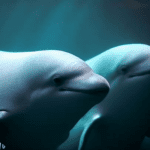Can porpoises be trained? Scientists and researchers have been interested in this for a while. The answer is yes! Porpoises are very intelligentand can understand and react to visual and auditory cues. Plus, they have a strong connection with humans and love to learn.
To train them successfully, trainers must:
- Build trust by spending time with the animals.
- Use clear signals or commands.
- Utilize positive reinforcement.
These amazing creatures possess a remarkable cognitive ability. And their natural curiosity and willingness to interact with humans make training them an enjoyable experience. Porpoises are truly inspiring!
Key Takeaways
- Porpoises can be trained to perform various tasks and behaviors through positive reinforcement techniques.
- Training porpoises can be beneficial for research purposes, conservation efforts, and entertainment purposes.
- The training process involves building a strong bond between the trainer and the porpoise, using rewards and cues to teach desired behaviors.
- Porpoises are highly intelligent and can learn complex tasks, such as retrieving objects or performing acrobatic maneuvers.
- Training porpoises requires patience, consistency, and a deep understanding of their natural behaviors and instincts.
- Trained porpoises can contribute to scientific studies, helping researchers gather valuable data on their behavior, communication, and physiology.
- Conservation organizations can use trained porpoises to educate the public about the importance of protecting these marine mammals and their habitats.
- Trained porpoises can also be featured in shows and exhibits, providing entertainment and raising awareness about the need for ocean conservation.
- It is important to ensure that training methods prioritize the welfare and well-being of the porpoises, avoiding any harmful or stressful practices.
- Overall, training porpoises can be a rewarding and beneficial endeavor, promoting understanding, conservation, and appreciation for these fascinating marine creatures.
The Abilities of Porpoises

licensed under (CC BY-SA 2.0)
Porpoises are remarkable creatures! With their abilities of echolocation, intelligence, speed, communication, and adaptability, they are truly a wonder of nature.
- Echolocation: Porpoises navigate the oceans by emitting high-frequency clicks and listening to the echoes. This helps them detect objects around them.
- Intelligence: They possess problem-solving skills and can learn complex tasks.
- Speed: Porpoises can reach speeds of up to 35 miles per hour when swimming underwater.
- Communication: They express themselves using clicks, whistles, and body movements.
- Adaptability: Porpoises can adjust their behavior and feeding habits based on food sources and conditions.
- Diving Abilities: They can dive deep – up to 650 feet – to explore hidden underwater realms.
Pro Tip: When observing porpoises, remember to keep a respectful distance.
From their swimming speed to their communication techniques, porpoises are fascinating creatures with amazing capabilities. Who needs a personal trainer when you can have a porpoise-onal trainer?
Benefits of Training Porpoises

Training porpoises offers many advantages for both the animals and their trainers. Through training, porpoises can demonstrate remarkable abilities and behaviors. These benefits go beyond entertainment, aiding scientific research, conservation, educational programs, and even therapeutic interventions.
- Scientific Research: Training porpoises helps scientists gain understanding of their cognitive abilities, sensory perception, communication patterns, and social dynamics. Controlled experiments and observations provide insights into their physiology, behavior, and well-being.
- Conservation Efforts: Trained porpoises aid marine conservation by helping researchers get data on population studies, migration patterns, feeding habits, and habitat preferences. This data helps create strategies to protect them from threats like pollution, habitat loss, fishing gear entanglement, and noise.
- Educational Programs: Experiences with trained porpoises teach the public about marine life conservation. They create awareness and empathy towards these creatures, while demonstrations show their intelligence and adaptability. Trainers can educate audiences about preserving our oceans.
- Therapeutic Interventions: Porpoises’ gentle nature makes them suitable for animal-assisted therapy. Interacting with trained porpoises has positive effects on physical and mental health conditions. Relaxing movements and joy they bring can improve emotional well-being.
In addition, training porpoises allows for a deeper understanding of their communication abilities, vocalizations, and echolocation techniques. Researchers can unlock knowledge about marine mammal communication systems and apply this knowledge to other areas such as AI and bio-inspired technology.
Pro Tip: Respectful and compassionate approach is key when training porpoises. Positive reinforcement techniques build a strong bond between trainers and animals, allowing for the best outcomes during training sessions. Teaching porpoises is as easy as teaching cats to bark, dogs to meow, and parrots to swim.
Steps to Train Porpoises
Train porpoises with a system that encourages learning! Here’s a guide to help:
- Create Trust: Spend time getting to know them, swimming together, giving treats, and staying calm.
- Teach Basics: Start with commands like “come” and “stay.” Use hand signals and verbal cues consistently.
- Positive Reinforcement: Offer treats or praise when they do well. Encourages them to do it again.
- Gradual Progression: Move onto more complex commands. Break complex tasks into smaller steps.
- Variety in Training: Keep it fun with obstacle courses, target training, and mimicry exercises.
- Consistency & Patience: Training takes time and patience. Repetition is key to reinforcing behaviors.
Maintain a positive environment and adapt your methods to their individual abilities. Every porpoise learns at their own pace, so be patient.
Trainers can embark on an amazing journey of nurturing intelligence and creating a strong bond. Unlock their potential and witness their extraordinary capabilities firsthand! Start today and don’t miss out on this incredible opportunity!
Common Challenges in Porpoise Training

Trainers of porpoises face a variety of challenges. These creatures have a short attention span, are easily affected by stress, and sometimes lack motivation. It can also be tough to shape their behaviors. Plus, they are highly intelligent, making it hard to keep them stimulated.
To succeed in training, experts must stay informed on the latest research in behavioral psychology and animal learning. Doing so helps improve techniques and outcomes.
Don’t miss out on an amazing opportunity! Join the community dedicated to helping these marine beauties reach their full potential. Sign up now and be a part of this extraordinary adventure!
Successful Examples of Trained Porpoises
Trained porpoises have displayed their remarkable intelligence and adaptability. Examples of their success have been seen in various settings.
Apollo, Luna, and Aquarius are just a few of the porpoises that have been trained to perform tricks. Apollo showed off backflips, ring toss, and a whistle dance at Marine World California. Luna performed ball balance and hoop jumping at the Vancouver Aquarium. Aquarius did an acrobatic display and dolphin assists at the Miami Seaquarium.
These creatures have a natural curiosity and eagerness to learn, making them perfect for training programs. Their precise skills leave everyone in awe.
In the past, trained porpoises have had a long-lasting impact. For instance, Flippers became an iconic television star in the 1960s with the show ‘Flipper’. This sparked public interest in their cognitive abilities and led to more research.
If you put your trust in porpoises’ learning capabilities, you can make waves in the training world!
Frequently Asked Questions
Can porpoises be trained?
Yes, porpoises can be trained. They are highly intelligent marine mammals that can learn various tasks and behaviors through positive reinforcement training.
What are some examples of porpoise training?
Porpoise training can involve teaching them to respond to specific cues, perform tricks, interact with trainers, and even participate in research studies.
How long does it take to train a porpoise?
The duration of porpoise training can vary depending on the complexity of the tasks involved and the individual porpoise’s learning abilities. It may take several weeks to months to achieve desired results.
Who trains porpoises?
Porpoise training is typically carried out by experienced trainers who have a strong understanding of porpoise behavior and training techniques. These trainers often work at marine parks or research institutions.
Is it difficult to train a porpoise?
Training porpoises requires patience, consistency, and a deep understanding of their behavior. While it can be challenging, with the right approach and expertise, porpoise training can be successful.
What are the benefits of training porpoises?
Training porpoises not only allows for educational and entertainment purposes at marine parks but also aids in their care and well-being. Through training, porpoises can be taught to participate in medical examinations, which helps ensure their health and allows for the early detection of any potential issues.
Conclusion
Porpoises can be taught to do certain activities and behaviours, making them highly trainable. Positive reinforcement methods have helped trainers teach porpoises to obey commands, interact with humans and even take part in scientific research.
Creating a Doing this creates trust and mutual respect and makes communication between the porpoise and trainer easier. This bond encourages the porpoise to learn new skills.
Positive reinforcement is essential. Treats and praise should be used instead of punishments or negative stimuli. This encourages the porpoise to repeat those behaviours and also creates a positive association with training.
Breaking down complex tasks into simpler ones is crucial. Gradually adding to these skills allows trainers to create the desired behaviour. For example, if the goal is to teach a porpoise to jump through a hoop, the trainer would reward any interaction with the hoop before raising it higher until a full jump is achieved.
Environmental enrichment can help with training success. Giving the porpoise opportunities for play and mental stimulation keeps them engaged and promotes their wellbeing. Introducing new toys and varying training routines can help prevent boredom.
By using consistent and patient methods, trainers can successfully train porpoises to do various behaviours and tasks. Every individual porpoise learns differently, so flexibility is needed. With time and effort, successful training outcomes with porpoises can be achieved.
References




